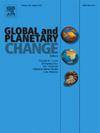Enhanced and southward North Pacific subtropical gyre circulation following the intensification of Northern Hemisphere Glaciation
IF 4
1区 地球科学
Q1 GEOGRAPHY, PHYSICAL
引用次数: 0
Abstract
The North Pacific Subtropical Gyre (NPSG) is critical for ocean heat distribution and climate regulation in the North Pacific and beyond. However, its variations across major climate transitions over long timescales remain poorly constrained. In this study, we reconstruct sea surface temperature (SST) and salinity (SSS) in the mid-latitude Northwest Pacific from 3.8 to 1.8 Ma using planktonic foraminiferal δ18O and Mg/Ca ratios from Deep Sea Drilling Project Site 296 and integrate paleorecords from the Kuroshio Current Extension (KCE), California Current (CC), and Alaska Current (AC) regions to investigate NPSG variability during the Late Pliocene Northern Hemisphere Glaciation (NHG). Pronounced increases in SST and SSS at Site 296 after the intensification of the NHG (iNHG) at 2.7 Ma reveal a strengthened Kuroshio Current with enhanced transport of warm saline waters. The concurrent SST increases in the CC and AC areas after ∼2.7 Ma indicate the intensification of all three NPSG boundary currents following the iNHG, resulting in a more robust NPSG circulation. Meanwhile, SSTs in the KCE and northern CC regions decreased considerably, implying southward displacement of the northern boundary of the NPSG. The post-iNHG enhancement and southward shift of the NPSG may have resulted from a more La Niña-like state in the equatorial Pacific and atmospheric circulation reorganization associated with high-latitude cooling in the Northern Hemisphere, as suggested by zonal and meridional SST gradients in the North Pacific. These findings highlight a possible weakening and poleward shift of the NPSG circulation in response to future warming.
北半球冰期增强后北太平洋副热带环流向南增强
北太平洋副热带环流(NPSG)对北太平洋及其他地区的海洋热分布和气候调节至关重要。然而,在长时间尺度上,主要气候转变的变化仍然没有得到很好的约束。本文利用深海钻探项目296站点的浮游有孔虫δ18O和Mg/Ca比值,重建了西北太平洋中纬度地区3.8 ~ 1.8 Ma的海温(SST)和盐度(SSS),并结合黑潮扩展(KCE)、加利福尼亚流(CC)和阿拉斯加流(AC)地区的古记录,研究了晚上新世北半球冰期(NHG) NPSG的变化。2.7 Ma NHG (iNHG)增强后296站点海温和SSS显著增加,表明黑潮增强,暖盐水输运增强。在~2.7 Ma之后,CC区和AC区海温同时升高,表明在iNHG之后,三个NPSG边界流都增强了,导致NPSG环流更加强劲。与此同时,KCE和CC北部地区的海温明显下降,表明NPSG北部边界向南移动。北太平洋纬向海温和经向海温梯度表明,赤道太平洋La Niña-like状态增强和北半球高纬变冷相关的大气环流重组可能导致了inhg后NPSG的增强和南移。这些发现强调了NPSG环流可能因未来变暖而减弱和向极地移动。
本文章由计算机程序翻译,如有差异,请以英文原文为准。
求助全文
约1分钟内获得全文
求助全文
来源期刊

Global and Planetary Change
地学天文-地球科学综合
CiteScore
7.40
自引率
10.30%
发文量
226
审稿时长
63 days
期刊介绍:
The objective of the journal Global and Planetary Change is to provide a multi-disciplinary overview of the processes taking place in the Earth System and involved in planetary change over time. The journal focuses on records of the past and current state of the earth system, and future scenarios , and their link to global environmental change. Regional or process-oriented studies are welcome if they discuss global implications. Topics include, but are not limited to, changes in the dynamics and composition of the atmosphere, oceans and cryosphere, as well as climate change, sea level variation, observations/modelling of Earth processes from deep to (near-)surface and their coupling, global ecology, biogeography and the resilience/thresholds in ecosystems.
Key criteria for the consideration of manuscripts are (a) the relevance for the global scientific community and/or (b) the wider implications for global scale problems, preferably combined with (c) having a significance beyond a single discipline. A clear focus on key processes associated with planetary scale change is strongly encouraged.
Manuscripts can be submitted as either research contributions or as a review article. Every effort should be made towards the presentation of research outcomes in an understandable way for a broad readership.
 求助内容:
求助内容: 应助结果提醒方式:
应助结果提醒方式:


